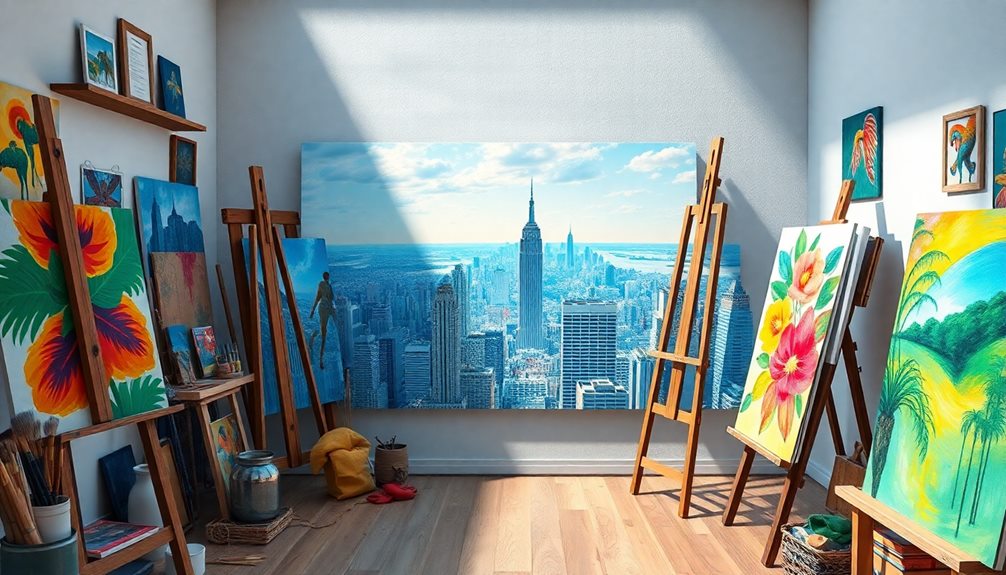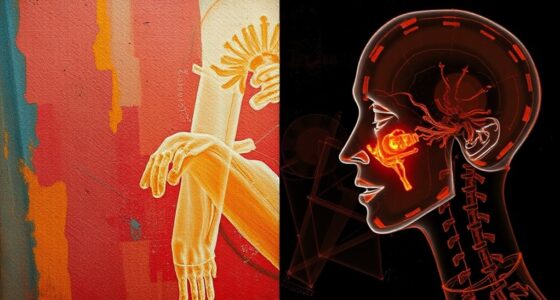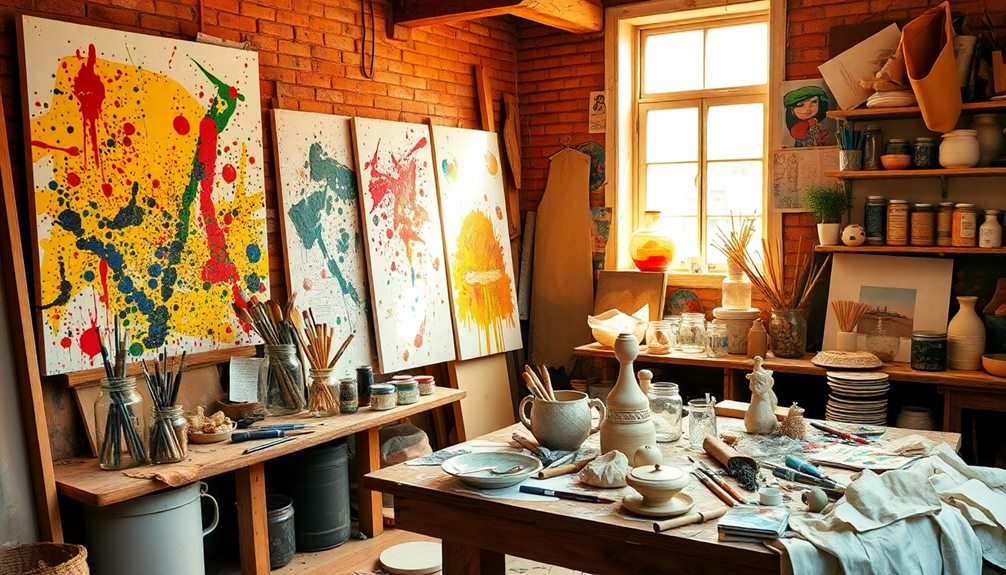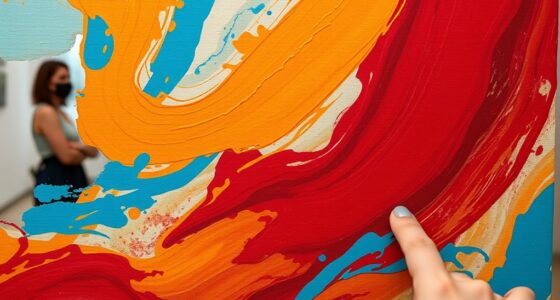Understanding perspective in artwork is vital for creating depth and realism. You start by establishing a horizon line at your eye level, which helps place vanishing points where parallel lines converge. Different types of perspective like one-point and two-point can guide your composition. Using techniques like linear and aerial perspective enhances the illusion of space, making your artwork more engaging. Be mindful of common mistakes, like misplacing the horizon line, as they can distort your scene. If you explore further, you'll uncover practical tips and resources to master these essential concepts.
Key Takeaways
- Perspective creates depth in artwork through techniques like linear and aerial perspective, enhancing spatial relationships and realism.
- The horizon line establishes eye level and is crucial for accurately placing vanishing points in compositions.
- Vanishing points guide the viewer's eye, helping to create a sense of three-dimensionality in artwork.
- Converging lines must be aligned correctly to maintain accurate proportions and enhance the illusion of depth.
- Regular practice and understanding of perspective principles are essential for improving skills in creating compelling artwork.
Introduction
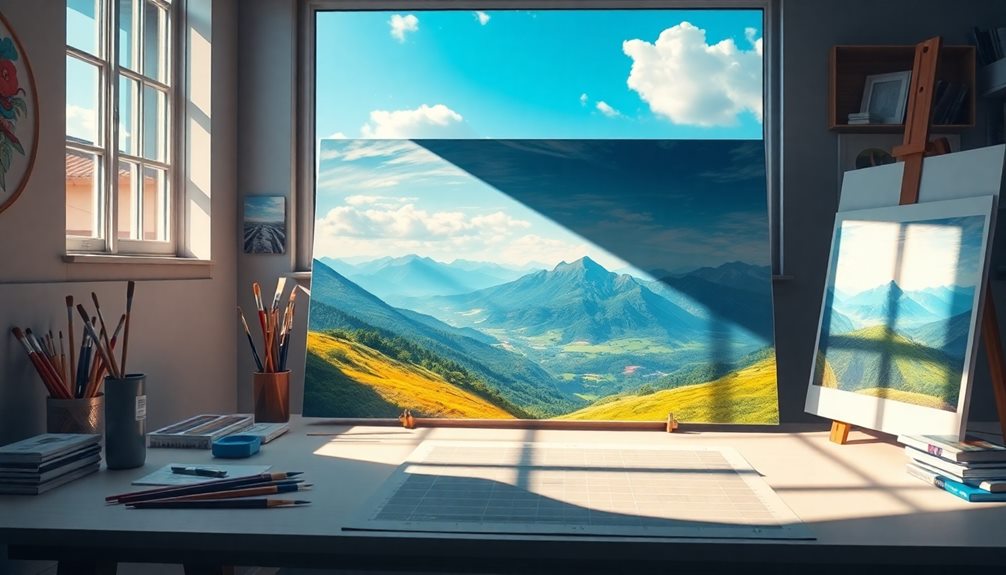
Understanding perspective in artwork is crucial, especially if you want to create a convincing sense of depth. Mastering perspective techniques helps you transform flat surfaces into dynamic three-dimensional spaces. One of the key aspects of this technique is the vanishing point, which acts as an anchor for your composition. It's where parallel lines seem to converge, drawing the viewer's eye into the artwork. This process can be likened to the way imagination mobilizes mental potential, allowing artists to reshape their creative reality.
The horizon line plays an equally important role, representing your eye level and serving as a reference point for placing vanishing points. When you're working with linear perspective, knowing where to position these elements can dramatically affect how realistic your work feels.
You'll often encounter various types of perspective, such as one-point, two-point, and three-point perspectives, each offering different ways to depict spatial relationships. These techniques are essential whether you're capturing the vastness of a landscape or the intricate details of architecture.
Key Concepts and Definitions

When it comes to perspective in artwork, grasping key concepts is essential for creating depth and realism. One of the foundational elements is the horizon line, which represents your eye level and helps establish the placement of vanishing points.
These vanishing points are where parallel lines converge, guiding your viewer's eye and forming spatial relationships within your work. Incorporating unique elements, similar to how antiques add character in country decor, can also enhance the visual interest in your art.
Linear perspective, the technique that utilizes vanishing points, can be categorized into one-point, two-point, and three-point perspectives. Each type employs a different number of vanishing points to achieve varying levels of depth and dimensionality. For example, one-point perspective focuses on a single vanishing point, while two-point perspective uses two to create a more dynamic view.
In addition to linear perspective, you should also consider aerial perspective, or atmospheric perspective. This technique allows you to depict distant objects as lighter and less detailed, mimicking how the atmosphere affects visibility and color saturation.
Essential Techniques for Perspective

Mastering essential techniques for perspective can dramatically elevate your artwork's depth and realism. Start by establishing the horizon line at your eye level; this line forms the backbone of your composition.
Next, utilize vanishing points along this horizon to direct your orthogonal lines, creating a sense of depth and spatial relationships. Depending on your scene, apply linear perspective techniques—one-point, two-point, or even three-point perspective—to align your lines towards those vanishing points, enhancing the realism of your work.
Additionally, consider incorporating aspects of color accuracy in projectors to understand how colors can interact with perspective in a visual composition.
Incorporate aerial perspective by varying color saturation and detail. Distant objects should appear lighter and less distinct, mimicking how we perceive the world naturally. This atmospheric perspective adds another layer of depth, making your artwork feel more immersive and lifelike.
Lastly, practice consistency in scale. Ensure that objects decrease in size proportionately as they recede into the background. This consistency is crucial for maintaining a coherent sense of depth throughout your piece.
Architectural Perspective Illustrations

Architectural perspective illustrations bring buildings to life by creating a realistic sense of space and depth. You'll often see techniques like one-point and two-point perspective used to accurately represent structures.
In one-point perspective, all lines converge at a single vanishing point on the horizon line, giving a straightforward view of the building. On the other hand, two-point perspective uses two vanishing points placed on the horizon line, allowing you to capture angular views of buildings, especially their corners, as they recede into the distance.
The horizon line plays a crucial role, as it represents your eye level, helping establish the scale and proportion of the structure relative to its surroundings. Orthogonal lines guide your eye toward these vanishing points, ensuring that parallel lines appear to converge, enhancing the three-dimensional effect.
Additionally, aerial perspective adds an atmospheric dimension, depicting how distant buildings become lighter and less detailed, further enhancing the illusion of depth in urban landscapes.
When you understand and apply these techniques, your architectural illustrations can effectively convey the grandeur and intricacies of the designs you're showcasing.
Tips and Best Practices

Five essential tips can help you improve your perspective illustrations and create more dynamic artwork.
First, always establish the horizon line at your eye level. This placement significantly influences how viewers perceive depth and structure in your piece.
Next, utilize vanishing points effectively by positioning them along the horizon line. This ensures that parallel lines converge realistically, enhancing the illusion of depth.
Third, apply orthogonal lines consistently. These lines guide the viewer's eye and maintain proper spatial relationships, ensuring all elements in your composition align with the vanishing points.
Fourth, practice drawing simple shapes in one-point and two-point perspective. This builds a solid foundation for understanding perspective before tackling more complex structures.
Viewer Engagement and Feedback

Effective perspective in artwork not only enhances visual appeal but also plays a crucial role in viewer engagement. When you encounter a piece that effectively employs perspective techniques, your eye is naturally guided through the composition, drawing you deeper into the scene. This engagement often leads to emotional responses, allowing you to feel a greater connection to the artwork's narrative and space.
The placement of the horizon line can significantly influence your perception. A higher horizon line might make you feel like you're looking down on the scene, while a lower line can immerse you within it. Additionally, manipulating scale enhances the illusion of three-dimensionality, making you perceive closer objects as larger and more significant.
Feedback from viewers is invaluable for artists. Your reactions to perspective can reveal how well an artwork communicates depth and space. By sharing your thoughts, you help artists refine their perspective techniques, ultimately enhancing viewer engagement.
The more effectively an artwork resonates with you, the more it can evoke the desired emotional responses, creating a lasting impact and connection in your viewing experience.
Common Perspective Mistakes

Many artists, both novice and experienced, often make common perspective mistakes that can undermine their work. One major error is misplacing the horizon line, which can distort spatial perception and make your composition feel unbalanced.
Incorrect placement of the vanishing point leads to unrealistic depth, causing objects to appear awkwardly scaled or misaligned. Additionally, failing to use orthogonal lines can skew proportions, making elements seem disjointed or out of perspective.
These lines are crucial for creating a cohesive spatial relationship in your artwork. Ignoring ground plane dynamics can flatten your piece, eliminating the essential three-dimensionality that perspective aims to achieve.
Overlooking converging lines further diminishes the illusion of depth, making it hard for viewers to grasp the intended spatial relationships within your artwork.
To avoid these pitfalls, always check the alignment of your vanishing point and ensure your orthogonal lines are consistent. By paying attention to these details, you'll enhance the illusion of depth and create a more believable and engaging composition.
Additional Resources

To deepen your understanding of perspective in artwork, consider exploring a variety of resources tailored for artists at every skill level. Online platforms like Skillshare and Udemy offer courses specifically focused on mastering perspective techniques, making it easy to find something that fits your needs, whether you're a beginner or an advanced artist.
For foundational knowledge, check out books like "Drawing on the Right Side of the Brain" by Betty Edwards and "Perspective Made Easy" by Ernest R. Norling. These texts provide practical exercises that enhance your understanding of perspective.
Additionally, the YouTube channel Proko features instructional videos on perspective drawing, offering visual demonstrations to help you grasp key concepts.
Don't forget about local art museums and galleries, which often host workshops and classes that include perspective drawing sessions. These hands-on experiences allow you to practice with professional feedback.
Finally, if you're venturing into digital art, software like Adobe Photoshop and Procreate includes built-in perspective grids and tools, allowing you to apply your understanding of perspective effectively in your creations.
Embrace these resources to elevate your skills in Perspective in Art!
Frequently Asked Questions
What Are the Four Types of Perspective in Art?
You'll find four main types of perspective in art: linear, atmospheric, multi-point, and curvilinear. Each type creates depth and space differently, helping you visualize and interpret two-dimensional works more effectively.
What Are the Three Rules of Perspective in Art?
The three rules of perspective in art are the horizon line, vanishing point, and orthogonal lines. By mastering these, you'll create depth and realism, making your artwork more engaging and visually compelling for viewers.
What Are the 3 Basic Types of Perspective and How They Impact Interpretations of an Artwork?
The three basic types of perspective—linear, aerial, and curvilinear—shape how you interpret artwork. Each creates unique spatial effects, guiding your focus, influencing mood, and altering your perception of depth and reality in the piece.
What Are Examples of Perspective in Art?
You'll notice perspective in art through works like Da Vinci's "The Last Supper," Van Gogh's "The Bedroom," and Monet's "Impression, Sunrise." Each example showcases unique techniques that shape your perception of depth and space.
Conclusion
By understanding perspective in artwork, you can elevate your creations and connect more deeply with your audience. Remember to practice the essential techniques and be mindful of common mistakes. Engaging with viewers and seeking feedback will only enhance your skills. Keep exploring additional resources to refine your understanding. Embrace the journey of mastering perspective, and you'll find your artwork becoming more dynamic and captivating. Dive in, experiment, and watch your artistic vision come to life!
